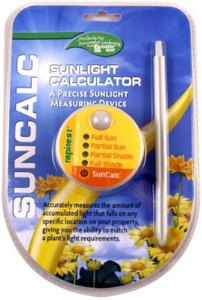A shade covered yard shouldn’t keep you from growing your own food.

Not everyone is lucky enough to have a sunny plot. Trees are great to climb and sit under, but not so much if you want grow vegetables. The first question you should ask yourself is “How much and what kind of shade do you have?” Not all shade is the same. Dappled shade under a tall tree is not equal to total shade on the north side of a building. There are several ways to determine how much sun you have on a given site. If you are more technological, there are devices that will give you an exact reading, like the Suncalc Sunlight Calculator. Just pop it into the ground in the morning on a sunny day (which isn’t always available here in Northeast Ohio), and by evening, it will tell you how much sunlight you have at that specific spot. I would recommend setting a phone alarm on your phone to remind you to pick it up at the end of the day. I once forgot about it for several days and thought a mushroom had popped up in the yard until I had a flash of memory.
Here is Suncalc’s definition of full sun through full shade:
Full Sun 6+
Partial Sun at least 4 hours up to 6
Partial Shade 1.5 to 4
Full Shade less than 1.5 hours

Another way to determine how much shade you have is to observe the current plants growing in your yard (including weeds). Both violets and ground ivy (shown below) are indicators you have at least partial shade (if not more sunlight). If the spot in question has issues even growing grass, you probably don’t have enough sun. Just remember that different times of the year will have different amounts of sunlight. For instance, in the spring before the trees leaf out will have much more sun than in the summer.
If you don’t have the time or patience to just observe the site, try some limited trial plantings in pots first. I’d also advise starting with the 2 to 4 hour veggies listed down below, especially the leafy greens. If those are successful, you can then try plants that need more sun.



2 to 4 hours
Herbs – Chives, Cilantro,Garlic,Lemon Balm, Mint, Oregano,Parsley,Thyme
Asian greens – bok choi, komatsuna, tatsoi
Mesclun
Mustard/Turnip Greens
Scallions
Arugula
Lettuce/mache
Kale
Spinach/Chard
4 to 5 hours
Peas/beans – bush
Root veg – beets, carrots, potatoes, radishes, turnips
Swiss chard with stalks
More than 6 hours per day
Tomatoes
Peppers
Eggplants
Corn
Squashes
Identify and Utilize Your Current Weeds
One possibility you probably didn’t think of is identifying and eating your yard weeds (of course only if you don’t spray chemicals on your lawn). Many of the “weeds” we despise are actually edible and good for you. Dandelions are an excellent example of this. The leaves (in the spring), flowers, and roots all can be eaten. I have a complete list at “Northeastern Ohio Edible Garden Weeds”
Mushrooms
Mushrooms are another solution you may not thought of. There are plenty of kits on the Internet that allow you to grow mushrooms under your trees, in your yard, on logs, or even inside your house!